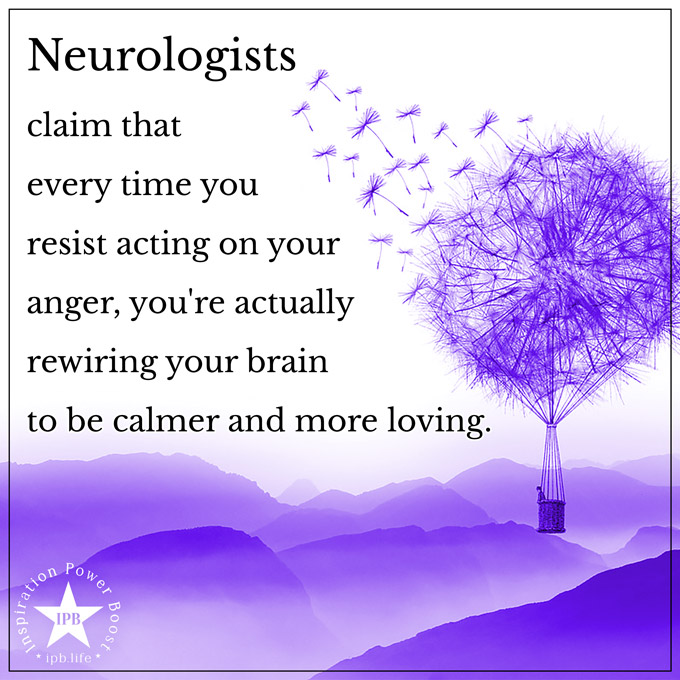
Neurologists Claim That Every Time You Resist Acting On Your Anger Graphic © Inspiration Power Boost
“Neurologists claim that every time you resist acting on your anger, you’re actually rewiring your brain to be calmer and more loving.”
Anger, a natural human emotion, can be both empowering and destructive. However, when we consciously choose to resist acting on it, we’re doing more than just exhibiting self-control. Neurologists have found that such resistance can lead to positive changes in the brain’s wiring. Each time we refrain from reacting impulsively to anger, neural pathways associated with calmness and love are strengthened. Over time, this can lead to a more peaceful and compassionate disposition, making it easier to handle future provocations with grace.
Neuroplasticity: The Brain’s Ability to Change
The brain’s ability to rewire itself is known as neuroplasticity. For many years, scientists believed that the brain’s structure was fixed and unchangeable after a certain age. However, recent research has shown that our brains are malleable and can change based on our experiences and actions. When we consistently choose positive behaviors, like resisting anger, we reinforce certain neural pathways while weakening others. This means that over time, our natural reactions can shift from anger and aggression to understanding and love.
Neuroplasticity, often referred to as brain plasticity, is a groundbreaking concept that has revolutionized our understanding of the brain. For decades, the prevailing belief was that the brain’s structure and function were largely static after childhood. However, neuroplasticity shatters this notion, revealing that the brain possesses an incredible ability to reorganize itself by forming new neural connections – throughout life.
This dynamic adaptability of the brain is not just limited to learning and memory. It plays a crucial role in recovery after brain injuries. For instance, when one part of the brain is damaged, another part can sometimes take over the lost function, thanks to the principles of neuroplasticity. This has been observed in stroke patients, where undamaged areas of the brain adapt and compensate for areas that have been harmed, aiding in the recovery of motor skills and speech.
Furthermore, the implications of neuroplasticity extend to mental health and well-being. Therapies that harness the power of neuroplasticity, such as cognitive-behavioral therapy (CBT), have shown promise in treating conditions like depression and anxiety. By actively reshaping thought patterns and behaviors, individuals can effectively “rewire” their brains, leading to lasting positive changes in their mental health. This understanding underscores the profound impact of our thoughts and actions on the very structure and function of our brains, emphasizing the limitless potential for growth and transformation.
There are also specialized new techniques for persons who have experienced actual brain injury. It’s almost like the mental equivalent of weightlifting. Specific individualized mental exercise programs are designed, that target the area of the brain where the healing is required. It may for example be a combination activity, such as physical movements performed in combination with puzzle exercises. The demand such training places on the brain sparks the brain’s neuroplastic ability for growth of new neurons.
The Fundamental Building Blocks of the Brain
The human brain, a marvel of biological engineering, is composed of intricate networks of specialized cells and structures that enable a plethora of cognitive functions and behaviors. At the heart of these networks lie neurons and synapses, fundamental components that play crucial roles in the processing and transmission of information. This report delves into the nature and function of these building blocks, shedding light on their critical role in the brain’s operation.
Neurons: The Brain’s Information Messengers
Neurons, often described as the basic working units of the brain, are specialized cells designed for transmitting information throughout the nervous system. Each neuron comprises three main parts: the cell body (or soma), dendrites, and an axon.
Cell Body (Soma): The cell body is the central part of the neuron containing the nucleus. It integrates incoming signals and generates outgoing signals to other neurons.
Dendrites: These tree-like structures extend from the cell body and are designed to receive information from other neurons. The more dendrites a neuron has, the more information it can receive.
Axon: This long, slender projection of the neuron conducts electrical impulses away from the cell body to other neurons, muscles, or glands.
Synapses: Junctions of Communication
Synapses are the critical junctions at which neurons communicate with each other. They are the points where the axon terminal of one neuron connects to the dendrite of another. Synapses are pivotal in determining how information flows through the brain’s neural networks.
Chemical Synapses: Most synapses in the brain are chemical. Here, neurotransmitters are released from the axon’s terminal in response to an electrical signal. These neurotransmitters cross the synaptic gap and bind to receptors on the receiving neuron, triggering a response.
Electrical Synapses: Less common are electrical synapses where cells are connected by gap junctions, allowing electrical signals to pass directly between neurons. These are faster but less versatile than chemical synapses.
Neurotransmitters: The Chemical Messengers
Neurotransmitters are chemicals that transmit signals across a synapse from one neuron to another. They can be excitatory, stimulating the next neuron, or inhibitory, reducing its likelihood to generate an action potential. Common neurotransmitters include dopamine, serotonin, and glutamate, each playing various roles in mood regulation, reward stimulation, and memory.
Embracing Calmness in Daily Life
And so we come full circle to emotional impulses! While it’s not always easy to resist anger, especially in challenging situations, the long-term benefits are profound. By practicing mindfulness, meditation, and other techniques that promote calmness, we can train our brains to default to a more loving response. This not only benefits our mental well-being but also improves our relationships and interactions with others. As we continue to resist anger and embrace love, we set ourselves on a path to a more harmonious and fulfilling life.
Daily Affirmation
“Today, I choose to respond with love and understanding, knowing that each positive choice I make reshapes my brain for the better.”
Similar Inspirational Quotes
“For every minute you remain angry, you give up sixty seconds of peace of mind.” – Ralph Waldo Emerson
“Holding onto anger is like drinking poison and expecting the other person to die.” – Buddha
“Anger does not solve problems – anger only makes things worse. I go by the old saying, ‘Don’t make important decisions when you’re angry.'” – Lionel Sosa
“The greatest remedy for anger is delay.” – Seneca
“When you are offended at any man’s fault, turn to yourself and study your own failings. Then you will forget your anger.” – Epictetus
😳 What Tinnitus Does To Your Brain Cells (And How To Stop It)
After 47 years of studies and countless brain scans done on more than 2,400 tinnitus patients, scientists at the MIT Institute found that in a shocking 96% of cases, tinnitus was actually shrinking their brain cells.
As it turns out, tinnitus and brain health are strongly linked.
Even more interesting: The reason why top army officials are not deaf after decades of hearing machine guns, bombs going off and helicopter noises…
Is because they are using something called "the wire method", a simple protocol inspired by a classified surgery on deaf people from the 1950s...
This Crazy Off Grid Device Literally Makes Drinkable Water From Fresh Air:
According to NASA, the U.S. is expecting a 100-YEAR LONG MEGADROUGHT.
It's already begun. Ask the farmers in California. They know.
Every survivalist knows that water is of critical importance. You NEED an independent water source that you can count on!
As an interesting "survival rehearsal" - imagine that you turned the tap on right now and nothing came out. How long would you last?
But what if there was another water source literally hidden in plain sight? That's right, I'm talking about the atmosphere!
The amazing thing about getting water from the natural moisture in the air... is that it is ALWAYS available.
This gives you real water security!
Learn more about how to tap into "Nature's secret water reservoir" and stay hydrated when TSHTF!
Watch the video:
Most People Don't Have The Guts To Try This:
An amazing discovery in an abandoned house in Austin, Texas: A lost book of amazing survival knowledge, believed to have been long vanished to history, has been found in a dusty drawer in the house which belonged to a guy named Claude Davis.
Remember... back in those days, there was no electricity... no refrigerators... no law enforcement... and certainly no grocery store or supermarkets... Some of these exceptional skills are hundreds of years of old and they were learned the hard way by the early pioneers.
>> Click here to find out about them now
We've lost to history so much survival knowledge that we've become clueless compared to what our great grandfathers did or built on a daily basis to sustain their families.
Neighbors said that for the last couple of years Claude has tried to unearth and learn the forgotten ways of our great-grandparents and claimed to have found a secret of gargantuan proportions. A secret that he is about to reveal together with 3 old teachings that will change everything you think you know about preparedness:






